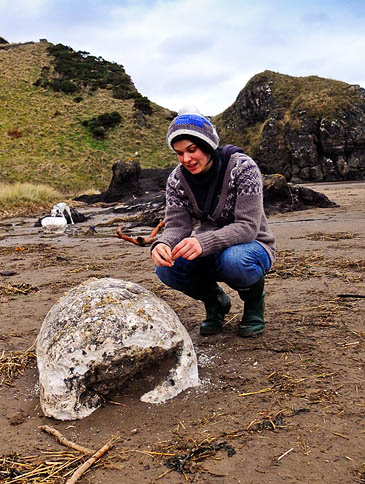Four huge lumps of lard have been washed ashore on a nature reserve after recent storms.
The bizarre finds are among a collection of oddities found at two reserves on the east coast of Scotland.
Scottish Natural Heritage said it believed the barrel-shaped pieces of lard have come from on old Second World War shipwreck.
The fatty deposits have hit the St Cyrus shore on Montrose Bay, with strange sea creatures also finding their way ashore and an old narrow-gauge railway being exposed at the Tentsmuir nature reserve.
Storms over the New Year holiday period are believed to be responsible for the strange sights.
SNH, which looks after the two reserves, said the lard was stored in wooden barrels, now long since rotted away, on a ship that was bombed in the war.
Bombing of merchant and other ships was common on the east coast of Scotland during the Second World War. It said the lard is still a brilliant white where animals have exposed it, under a thick crust of barnacles.
The lard has appeared before at St Cyrus, but not for many decades.
Angus McHardy, a local resident and retired fisherman, said he remembers the lard appearing on the beach back in early 1940s.
“I’d never seen anything like it,” Mr McHardy said. “There was quite a lot washed up at St Cyrus and beyond – not quite to Montrose.
“Some barrels were complete and others were just lumps. People collected it. My grandma boiled it up to get the sand out. It was great because we couldn’t get fat during the war.
“I used to see the convoys for the merchant ships on my way home from school. The Germans attacked the convoys at the same time every night.
“After a storm in the late 60s or early 70s, the lard came up on shore again. The seagulls thought it was a bonanza.”
Therese Alampo, St Cyrus reserve manager, said: “The depth of the swell during the storms we had over the holidays must have broken apart the shipwreck some more and caused the lard to escape.
“It’s given us some interesting sights recently on the reserve: I’m sure there have been people wondering what on earth has washed up on the beach. The lard was covered in the largest barnacles I’ve ever seen.
“Animals, including my dog, have certainly enjoyed the lard, and it still looks and smells good enough to have a fry up with.”
SNH staff remember lard coming ashore in the early 1980s as well. At that time, there was a pair of barn owls nesting on a rocky ledge near the reserve office. A dead barn owl was later found on the beach plastered with lard.
Down the coast at Tentsmuir nature reserve, erosion from the storms has exposed a narrow-gauge railway line that was used during the Second World War.
Sections of corrugated iron which were used as moulds to create the coastal sea defences, the concrete anti-tank traps, have also been exposed.
The storms also swept all kinds of creatures and shells onto Tentsmuir’s beaches, including a dead octopus, sea anemones and some unusual sealife which was eventually identified as dead man’s finger sponge.
Tom Cunningham, Tentsmuir’s reserve manager said: “Not only is Tentsmuir’s wildlife terrific, but its involvement in World War II is also fascinating.
“The landscape here is constantly shifting, pushing out the northern coastline by up to five metres a year in some spots, while the sea is eroding the dune edge at the south end of the reserve.
“So, every now and then, we see amazing remnants from World War II emerging from the sands. All the shells and creatures from the storms were wonderful to see as well – a great reminder of all that we can’t see below the waves.”
At Tentsmuir, a line of concrete anti-tank blocks and pillboxes was installed along the shore in 1941. The defences were dual purpose: to counter invasion but also to protect the Leuchars airfield, from where crews were engaged in anti-shipping and mine laying operations along the coast of northern Europe.
Anti-glider posts were also installed on the foreshore, but many are now buried. The area is listed as a scheduled monument, called Tentsmuir Coastal Defences, because of its historical importance.
